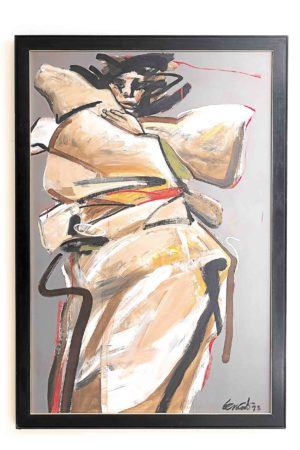Fine art as fine investment
Buying art is becoming increasingly popular. More and more people are showing interest in acquiring a piece of art for their home, especially since artworks can be viable investments, too. The frequency of art fairs and art markets have also helped encourage art appreciation among a wider market. It’s easy to get lost, however, through the decision-making process of purchasing, for instance, a painting. Having the good fortune to acquire an original by a master is another story.
We asked the help of Inquirer Lifestyle Arts and Books editor Lito B. Zulueta for tips on how to choose an art piece for those who are planning to build their own little art collection at home.
If you are yet undecided on what kind of art will look good in your home, Zulueta suggests on abstract works. “Since abstract works are non-representational, any viewer can read or interpret them any which way. And since abstract works rely mainly on lines and colors and “gestural” techniques, they can be seen as colorful and dynamic and could fit in—and meld with—any wall,” he explained.
Philippine art has quite a number of abstract artists. Zulueta suggested some Filipino top abstractionists with a brief explanation of each one’s style: Jose Joya, whose “Space Transfiguration” was auctioned off for P112.28 million last March, making it the most expensive Philippine painting ever sold; national artist J. Elizalde Navarro, whose erotic abstract works are beautiful, stimulating and even whimsical;

Carlos “Botong” Francisco art pieces have the most local feel to it, commonly viewed as the most “Filipino” among the masters.
Raul Isidro, who usually combines the abstract and the figurative and whose works, particularly his prints, are also pocket-friendly; Edwin Wilwayco, a master of gestural abstract expressionism with such impressive brushwork and colorism;
Article continues after this advertisementLao Lianben, whose mostly monochromatic, Zen-like paintings are very meditative and even philosophical; the very intellectual and also philosophical Gus Albor; and Alan Cosio, who uses vibrant colors.
Article continues after this advertisementAccording to Zulueta, “modern art is the most viewer-friendly” compared to contemporary art. “It’s not hysterical and overdramatic, not shallow, pretentious and literalist, like contemporary art,” he added.
Those who would prefer to have a sculpture in their home should check out the works of Eduardo Castrillo, Ramon Orlina, Julie Lluch, Solomon Saprid and Agnes Arellano, among others. “Modern sculptures are also recommended for living spaces,” said Zulueta.
Who hasn’t dreamed of having a master right at his or her very own wall at home? Paintings done by the Philippines’ masters are, of course, “display-worthy.” “You can’t go wrong with an Amorsolo, a Fabian de la Rosa, a Manansala in your living room,” Zulueta said. It is important to note, though, that masters are the most copied and forged. Further, getting authentic pieces might be more complex than you expect.
If you want art pieces that have a most local feel to it, you should see the works of muralist Carlos “Botong” Francisco, the most “Filipino” among the masters. “He’s often mistaken for a Mexican muralist, but really, the Mexican and Philippine styles (of Botong) complement each other,” Zulueta explained.
National artists Ang Kiukok and Benedicto “Bencab” Cabrera are also two artists whose works are both “investment-worthy” and “wall-friendly.” According to Zulueta, “Their works are always exciting and provocative and, yes, beautiful. No debate about that.”
If your taste leans more towards contemporary art, Zulueta suggested Ronald Ventura and Elmer Borlongan. The works of Andres Barrioquinto, Rodel Tapaya, Daniel Coquilla, Farley del Rosario and Lindslee are also worth considering to invest on. Charlie Co, though slightly older than most contemporary artists, is very good, too.
Zulueta, however, explained, “There’s a difference between investing in art works and putting them up on display to decorate one’s home. Art works that you buy primarily as investment may not exactly be the correct works to display and vice-versa. As a rule, one buys an art work because one likes it; investment and décor are secondary considerations,” Zulueta said.

